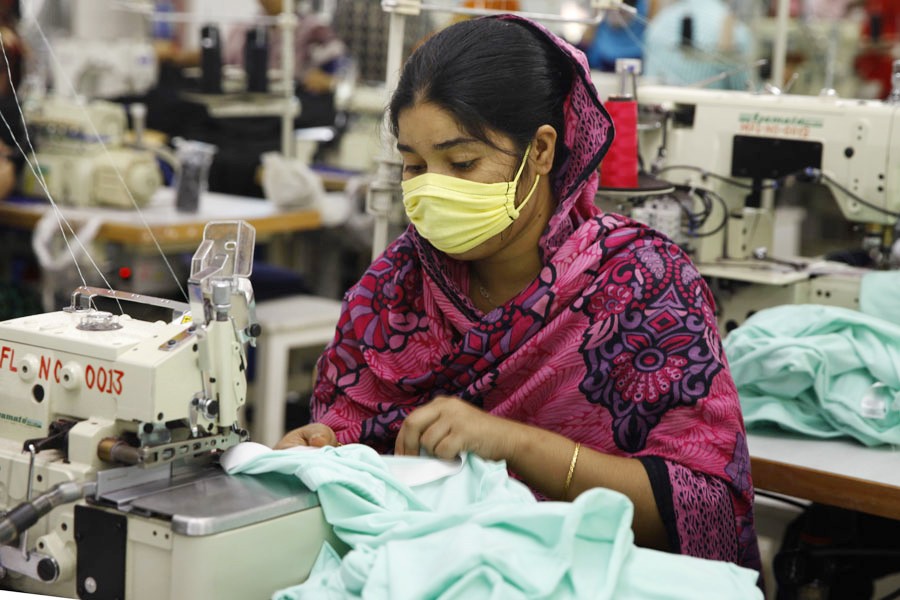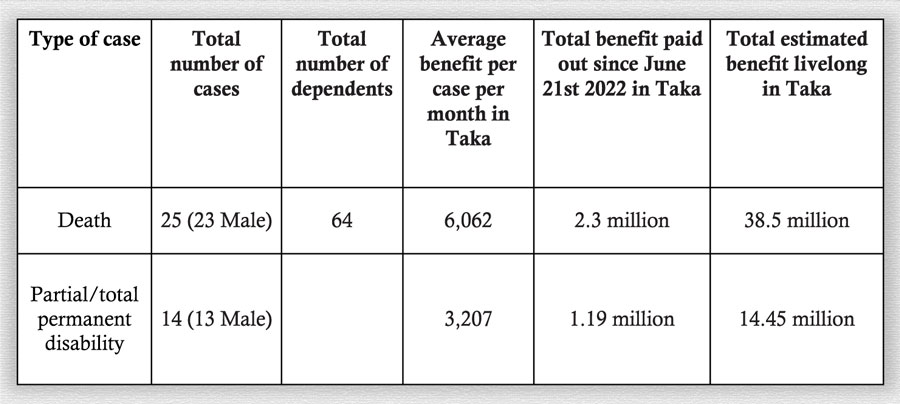
Employment Injury Scheme Pilot
A safety net for RMG workers in BD
Hasnat M Alamgir | Wednesday, 7 August 2024

 Bangladesh has implemented the Employment Injury Scheme Pilot (EIS-PILOT) to help compensate workers in the readymade garment (RMG) industry who sustain workplace injuries or lose their lives. This programme aims to give RMG employees and their families some measure of financial stability. To help the government of Bangladesh, employers, and workers' organisations are implementing the EIS-PILOT with collaboration and technical support from the International Labour Organisation and the Deutsche Gesellschaftfür Internationale Zusammenarbeit (GIZ) . The German Federal Ministry for Economic Cooperation and Development (BMZ) funds the GIZ initiative, while the governments of the Netherlands and Canada fund the ILO initiative. Many global brands have contributed financially to this initiative by allocating a portion of their Bangladeshi RMG export volume. This financial model is to ensure a consistent and reliable source of income for the impacted workers.
Bangladesh has implemented the Employment Injury Scheme Pilot (EIS-PILOT) to help compensate workers in the readymade garment (RMG) industry who sustain workplace injuries or lose their lives. This programme aims to give RMG employees and their families some measure of financial stability. To help the government of Bangladesh, employers, and workers' organisations are implementing the EIS-PILOT with collaboration and technical support from the International Labour Organisation and the Deutsche Gesellschaftfür Internationale Zusammenarbeit (GIZ) . The German Federal Ministry for Economic Cooperation and Development (BMZ) funds the GIZ initiative, while the governments of the Netherlands and Canada fund the ILO initiative. Many global brands have contributed financially to this initiative by allocating a portion of their Bangladeshi RMG export volume. This financial model is to ensure a consistent and reliable source of income for the impacted workers.
The majority of industrialised nations have long had workers' compensation programmes in place to compensate for lost income, provide medical care, and provide rehabilitation services to employees who are ill or injured at work. Although there are some shared ideals and comparable benefit packages among workers' compensation statutes, each country has its own unique set of regulations governing the amount and kinds of benefits provided and the organisational structures and procedures used to carry them out. Employees who wish to file a claim must inform their employer of the illness or injury and adhere to the rules established by the workers' compensation board or agency in question. Employers are typically obliged to maintain workers' compensation insurance.
Workers' compensation provisions 1) pay for medical costs associated with the disease or injury, such as prescription drugs, hospital stays, surgeries, doctor visits, and rehabilitation services ; 2) pay for lost income in the event the illness or injury prevents the worker from going to work. (Depending on the extent and length of the impairment, these can include temporary total disability, temporary partial disability, permanent total disability, and permanent partial disability); 3) offer services to assist injured workers in finding gainful employment again, such as job placement, education, and training; 4) provide money to a worker's heirs in the event of an illness or injury sustained on the job which this can cover burial costs as well as continuing financial assistance for the employee's family, 5) employers are given legal protections through workers' compensation, which restricts employees' capacity to file lawsuits for diseases or injuries sustained on the job (employees typically give up their right to sue their employer in exchange for these benefits).
It is important to remember that each state or nation has very different workers' compensation laws and benefits. There can be major variations in specific formulas, benefit caps, and eligibility requirements.
The EIS-PILOT programme in Bangladesh offers several significant benefits, including monetary compensation for dependent family members if an accident at work results in a worker's death or permanent disability. This entails a pension to support their way of life in addition to a lump sum payment. This programme's mandate requires it to gather a lot of information on workplace accidents and injuries, as well as the resulting losses and medical expenses. This is required to guarantee that programme implementation is successful and workplace safety standards are met.
About 150 factories, employing at least 150,000 people, are taking part in this component, according to official and public data. A summary of the benefits paid so far from the program's launch on June 22, 2022, to July 31, 2024, is displayed in the table.
Upon examining the released figures, various observations can be made. In the RMG sector, males account for the majority of both fatal and non-fatal cases (23 out of 25 fatal cases and 13 out of 14 disability cases), even though female workers make up the majority of workers in this sector. Further research is required to determine whether there is a gender disparity in the reporting or compensation of cases, even though it is plausible that men are working in more dangerous jobs or are less concerned about their safety, which results in their illnesses and deaths. With the size of the workforce and the number of factories, the numbers that have been released thus far appear low. There were 25 fatalities out of 150 factories and from 150,000 workers or one fatal case for every 6 factories or 6000 workers over two years. However, the safety situation at the RMGs may indeed have improved over the last decade with all the programmes, policies, and interventions undertaken by the national and international stakeholders.
The dependents of the deceased workers receive a monthly compensation of 6,062 TK, which is quite low considering the recent sharp increase in living expenses. This sum is simply insufficient because there were 2.5 dependents of every worker. The 3,207 TK monthly benefit for a worker with a partial or total permanent disability is also low. Periodically, these amounts must be adjusted to account for changes in national prices. The EIS provides minimal benefits, even though some of them may also receive benefits from other sources such as the central fund or other social safety nets.
It seems that a comprehensive review of the EIS programme is underway with the goal of making it better and adding more cases that are not currently covered. One positive development is the addition of worker-injured commuter accidents. However, the lack of coverage for occupational diseases is a significant drawback. These result directly from being exposed to risk factors or hazards related to a specific job or workplace. Unlike occupational injuries, which usually occur suddenly, occupational diseases usually occur gradually as a result of repeated tasks, extended exposure to hazardous materials, or other workplace-related factors.
Nonetheless, the EIS-PILOT is a major step toward improving the social security system for Bangladesh garment industry, offering a safety net for workers, and fostering a more secure and healthy work environment.
Hasnat M Alamgir is a Professor at Southeast University.
hasnat.md.alamgir@gmail.com